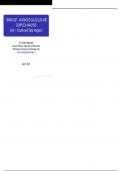Class notes
ACCA Unit 1 Double and Triple Integrals Class Notes
- Course
- Institution
Class notes for Course 18MAB102T - Advanced Calculus and Complex Analysis, Unit 1, focusing on Double and Triple Integrals. Designed for students seeking a comprehensive understanding of these fundamental concepts, our notes offer a clear and concise explanation of key topics including the theory...
[Show more]



